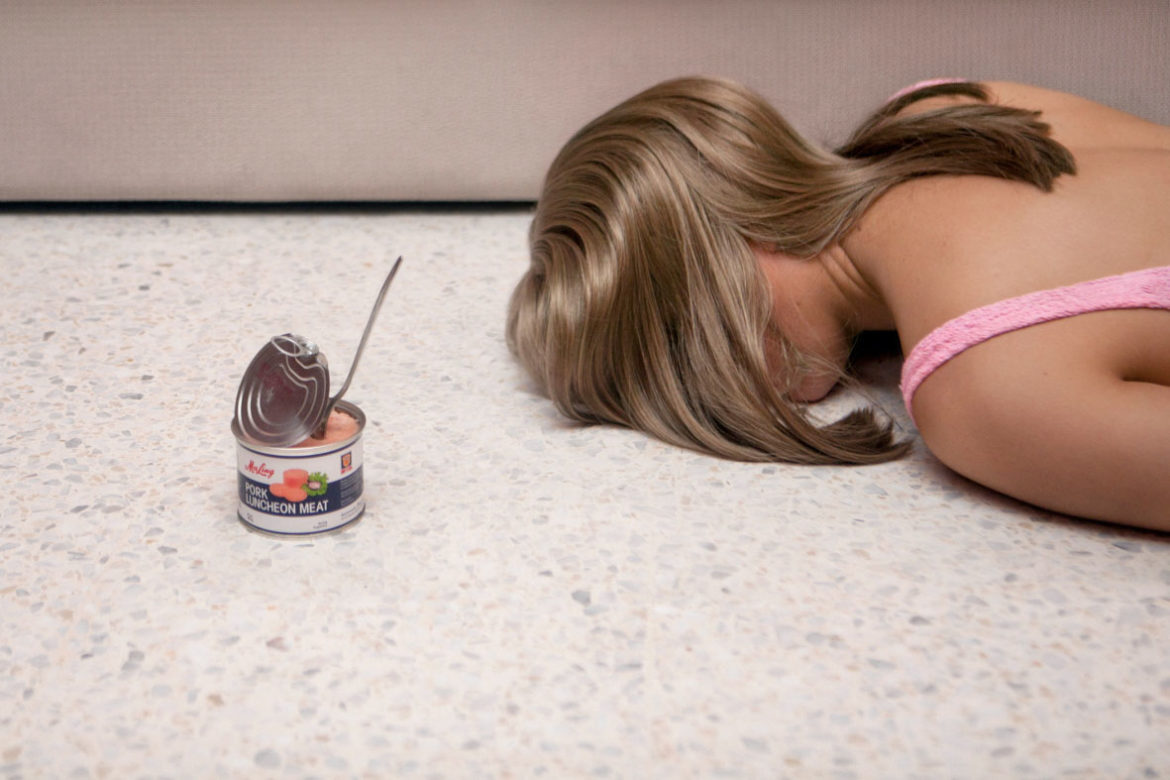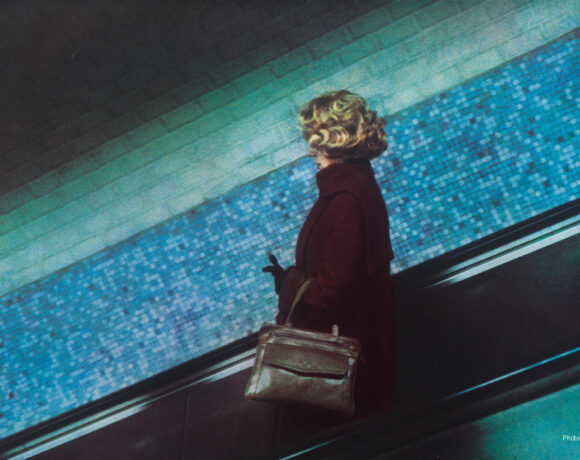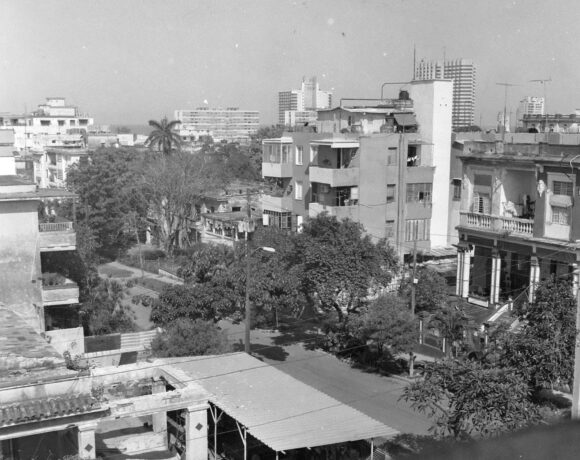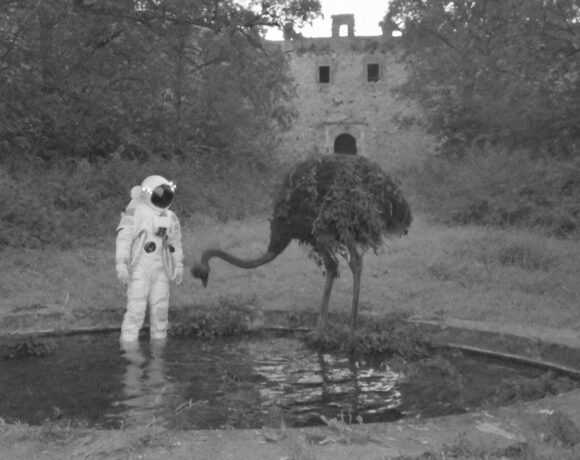Studio Giangaleazzo Visconti in Milan houses for the first time in Italy, the Pop-Pink atmosphere and aesthetics of Juno Calypso. Young London artist, she has been working with self-portraits, she exhibits worldwide and is known for her Photography Awards 2016, one of the most sought-after prize in photojournalism sector organised by British Journal of Photography.
We enter a cosy and sugary atmosphere based on 60s and 80s years, where irony and sarcasm try to cross prejudices and clichés referred to the modern woman; settings like American motels and bunkers in Las Vegas become places where the artist explores her new characters.
Walking through the halls of the art gallery, we find a wide range of photographs, selected among the 3 most significant series took by Juno: Joyce, The Honeymoon and What to do with a Million Years.
During university, Juno began a series of self-portraits disguised as a fictional character called Joyce. Secretly photographing herself at her grandmothers’ house or in bedrooms rented online, Juno was used to enact the private life of a woman wasted by labour of femininity and lead to the “ritualised absurdity”. Joyce is a woman looking convulsively for perfection, who uses treatments and devices to improve her body; a woman that frustrated pursues continually herself through her alter ego.
The artist thinks that every single detail of her set, from the artificial light to the clothing, every element is fundamental for the result of her dreamy scene.
In the Honeymoon series (2015) the protagonist is always solitary and never gloomy. Juno spent a week alone in a resort for couples, the Penn Hills Resort in Pennsylvania and by bringing with her a bag full of wings and lingerie, she starts to play with her characters, where rooms become stage, a place where to perform, where to act alone expressing desire and disappointment. In those days, Juno used to go out only to have breakfast or dinner, she dedicated all the rest of her time to her shots. In 2016, she came back to the same hotel to continue the series by simulating a real honeymoon.
What to do with a Million Years is her new project made in 2018. Here the set has changed, no more rent house or motel, but a two-floor house in Las Vegas with a worrying “Bunker” underneath it; the Bunker was built at the end of 1960 by a rich makeup businessman, Avon Gerry Henderson and by his wife, since they were terrified by a possible nuclear explosion with the advent of cold war.
Juno found out, only after she had taken her pictures, that such bunker actually is owned by a company related to “cryonics”, the science that hibernates bodies in liquid nitrogen. All that makes the artist’s project even more worrying and attractive.
The bunker, in the artist’s imagination, exists to be lived daily with all its thousand comforts: hydromassage, guest rooms, pool, dancing room and garden; it has been chosen right because it is the symbol of a place which withstands everything, especially death.
Juno Calypso hides herself into the den built using the billions of the beauty industry to “save” people from death (one of the strongest human fear) and she puts us a question:
“What if we could live forever?” this query is even more powerful for all those humans who have always been obsessed by death and, especially for those who have always believed in immortality. The artist wants us to believe just that there are other lives beyond the one we are living now, with thousand characters and infinite personalities which alternate; hers is an invitation to eternal life where all is rosier and more sublime.
By looking at those works we get confused between a state of visual wellness, thanks to pastel tints, and fear, because after all the thought of immortality is not always pleasant.
During her visit to that house, the artist tells us these words:
“You enter the house via an old escalator that moves slowly hearing the drip of the pool filter. The air is filled with the smell of chlorine, like a park in a holiday resort indoors. There are air inlets that let the air circulate regularly from the above; apart from that, the rest is silent. There are four lanes above your head but you cannot hear anything. It’s a place loaded with all the surreal peace of a film set.”
During her last project, the artist was inspired by the essays and brochures she found inside this house on a glass piece of furniture.
In the whole exhibition itinerary at Studio Visconti, we find different works:
Erotic nightmares, 2018, where a figure appears against the light, while through the folds and transparency of the curtain, we can catch the “garden of wonders”. Other side curtains frame the scene; the blue atmosphere recalls the night and mystery, while the silhouette of the female body represents sensuality.
Also in the works Tuesday in Eternity and A Cure for death made in 2018, windows and curtains are constant elements.
In the first one, there is no human presence and the visual balance of architecture, furniture, windows and curtains is highlighted; in the second one, the voyeuristic view is more evident, since binoculars are turned from the outside to the inside, where Juno’s figure appears, but only through a detail, her legs.
A work that expresses bliss, but also loneliness, is of course Milk made in 2016, here the artist dives into a heart-shaped bathtub and full of milk; only a part of her face sticks out and behind it there is a large glass that reflects the bathtub or better “pieces of heart”.
In The First Night made in 2015, Juno tells her “first night”, a lonely honeymoon; with the veil and a wig, she pretends to be a bride immersed in a night atmosphere all in blue. The honeymoon is usually a couple event; here the artist represents it on her own. In this case irony prevails.
Works like Disenchanted Simulation, Routine Delusion and Reconstituted Meat Slices, made in 2013, are totally wrapped by the pink colour, and here, in her self-portraits, her face is always covered by something, a book, a pillow, or hair: her alter ego is shown and hidden at the same time.
The air that we breathe into the gallery is mixed and eclectic, on one side we find beauty and contrast of perfect ambiences, on the other side we find the worrying approach to the story of those places and the silent atmosphere that the artist can create in her sets.
Juno Calypso is desire, fear and irony. It is aesthetic perfection against the aesthetic itself.
Benedetta Spagnuolo
Info:
Juno Calypso
Studio Giangaleazzo Visconti
Corso Monforte 23 – Milano
24th October 2018 / 11th January 2019
info@studiovisconti.net
www.studiovisconti.net
 Juno Calypso, Reconstituted Meat Slices, 2013
Juno Calypso, Reconstituted Meat Slices, 2013
 Juno Calypso, Milk, 2016
Juno Calypso, Milk, 2016
 Juno Calypso, Routine Delusion, 2013, 76x51cm, Archival pigment print, ed 1di 51
Juno Calypso, Routine Delusion, 2013, 76x51cm, Archival pigment print, ed 1di 51
 Juno Calypso, Stretch, 2017
Juno Calypso, Stretch, 2017
 Juno Calypso, Disenchanted Simulation, 2013, Archival pigment print, Ed 4 di 5+2Ap1
Juno Calypso, Disenchanted Simulation, 2013, Archival pigment print, Ed 4 di 5+2Ap1
 Juno Calypso, Erotic nightmares, 2018, Archival pigment print, ed 3 di 51
Juno Calypso, Erotic nightmares, 2018, Archival pigment print, ed 3 di 51
 Juno Calypso, A Cure for death, 2018, From the series What To Do With A Million Years
Juno Calypso, A Cure for death, 2018, From the series What To Do With A Million Years
For all the images ph Courtesy by Juno Calypso and Studio Giangaleazzo Visconti
She graduated at the Academy of Fine Arts in Catania. During her lifetime, she has experienced various arts including sculpture, theatre, dance and photography, and the latter one became the springboard for her eclectic and innovative artistic path. In 2010, she approached the art curatorial world and started to write reviews and critical texts; later, she founded “Artisti Italiani – arti visive e promozione”, an organisation which deals with all the promotional aspects of contemporary art.







NO COMMENT